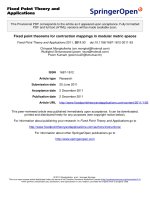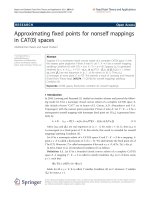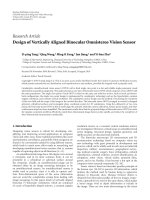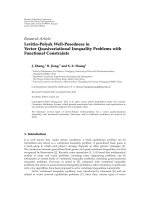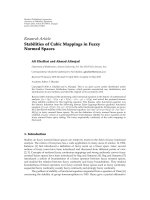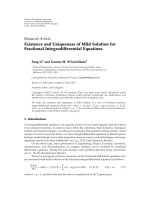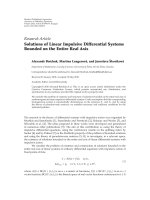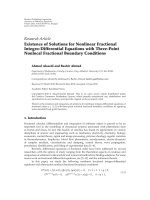Báo cáo sinh học: " Research Article Stabilities of Cubic Mappings in Fuzzy Normed Spaces" pptx
Bạn đang xem bản rút gọn của tài liệu. Xem và tải ngay bản đầy đủ của tài liệu tại đây (521.87 KB, 15 trang )
Hindawi Publishing Corporation
Advances in Difference Equations
Volume 2010, Article ID 150873, 15 pages
doi:10.1155/2010/150873
Research Article
Stabilities of Cubic Mappings in Fuzzy
Normed Spaces
Ali Ghaffari and Ahmad Alinejad
Department of Mathematics, Semnan University, P.O. Box 35195-363, Semnan, Iran
Correspondence should be addressed to Ali Ghaffari, aghaff
Received 15 January 2010; Revised 19 April 2010; Accepted 11 May 2010
Academic Editor: T. Bhaskar
Copyright q 2010 A. Ghaffari and A. Alinejad. This is an open access article distributed under
the Creative Commons Attribution License, which permits unrestricted use, distribution, and
reproduction in any medium, provided the original work is properly cited.
Rassias 2001 introduced the pioneering cubic functional equation in the history of mathematical
analysis: fx 2y − 3f x y3fx − fx − y6fy and solved the pertinent famous
Ulam stability problem for this inspiring equation. This Rassias cubic functional equation was
the historic transition from the following famous Euler-Lagrange-Rassias quadratic functional
equation: fxy−2fxfx−y2fy to the cubic functional equations. In this paper, we prove
the Ulam-Hyers stability of the cubic functional equation: fx3y−3fxy3fy−
x−fx−3y
48fy in fuzzy normed linear spaces. We use the definition of fuzzy normed linear spaces to
establish a fuzzy version of a generalized Hyers-Ulam-Rassias stability for above equation in the
fuzzy normed linear space setting. The fuzzy sequentially continuity of the cubic mappings is
discussed.
1. Introduction
Studies on fuzzy normed linear spaces are relatively recent in the field of fuzzy functional
analysis. The notion of fuzzyness has a wide application in many areas of science. In 1984,
Katsaras 1 first introduced a definition of fuzzy norm on a linear space. Later, several
notions of fuzzy norm have been introduced and discussed from different points of view
2, 3. Concepts of sectional fuzzy continuous mappings and strong uniformly convex fuzzy
normed linear spaces have been introduced by Bag and Samanta 4. Bag and Samanta 5
introduced a notion of boundedness of a linear operator between fuzzy normed spaces,
and studied the relation between fuzzy continuity and fuzzy boundedness. They studied
boundedness of linear operators over fuzzy normed linear spaces such as fuzzy continuity,
sequential fuzzy continuity, weakly fuzzy continuity and strongly fuzzy continuity.
The problem of stability of functional equation originated from a question of Ulam 6
concerning the stability of group homomorphism in 1940. Hyers gave a partial affirmative
2 Advances in Difference Equations
answer to the question of Ulam for Banach spaces in the next year 7.LetX and Y be Banach
spaces. Assume that f : X → Y satisfies fxy−fx−fy≤ for all x, y ∈ X and some
>0. Then, there exists a unique additive mapping T : X → Y such that fx − Tx≤
for all x ∈ X. Hyers
,
theorem was generalized by Aoki 8 for additive mappings. In 1978, a
generalized solution for approximately linear mappings was given by Th. M. Rassias 9.He
considered a mapping f : X → Y satisfying the condition
f
x y
− f
x
− f
y
≤
x
p
y
p
1.1
for all x, y ∈ X, where ≥ 0and0≤ p<1. This result was later extended to all p
/
1.
In 1982, J. M. Rassias 10 gave a further generalization of the result of Hyers and prove
the following theorem using weaker conditions controlled by a product of powers of norms.
Let f : E → E
be a mapping from a normed vector space E into a Banach space E
subject to
the inequality
f
x y
− f
x
− f
y
≤
x
p
y
p
1.2
for all x, y ∈ E, where ≥ 0and0≤ p<1/2. Then there exists a unique additive mapping
L : E → E
which satisfies
f
x
− L
x
≤
2 − 2
2p
x
2p
1.3
for all x ∈ E. The above mentioned stability involving a product of powers of norms is called
Ulam–Gavruta–Rassias stability by various authors 11–25.
In 2008, J. M. Rassias 26 generalized even further the above two stabilities via a new
stability involving a mixed product-sum of powers of norms, called JMRassias stability by
several authors 27–30.
In the last two decades, several form of mixed type functional equation and its Ulam–
Hyers stability are dealt in various spaces like Fuzzy normed spaces, Random normed spaces,
Quasi–Banach spaces, Quasinormed linear spaces and Banach algebra by various authors like
31–40.
In 1994, Cheng and Mordeson 2 introduced an idea of a fuzzy norm on a linear space
whose associated metric is Kramosil and Mich
´
alek type 41. Since then some mathematicians
have defined fuzzy metrics and norms on a linear space from various points of view 42–44.
In 2001, J. M. Rassias 45 introduced the pioneering cubic functional equation in
history of mathematical analysis, as follows:
f
x 2y
− 3f
x y
3f
x
− f
x − y
6f
y
, ∗
and solved the famous Ulam stability problem for this inspiring functional equation. Note
that this cubic functional equation
∗ was the historic transition from the following famous
Advances in Difference Equations 3
Euler-Lagrange quadratic functional equation:
f
x y
− 2f
x
f
x − y
2f
y
1.4
to the cubic functional equation ∗.
The notion of fuzzy stability of the functional equations was initiated by Mirmostafaee
and Moslehian in 46. Later, several various fuzzy versions of stability were investigated
47, 48. Now, let us introduce the following functional equation:
f
x 3y
− 3f
x y
3f
x − y
− f
x − 3y
48f
y
. 1.5
Since the cubic function fxcx
3
satisfies in this equation, so we promise that 1.5
is called a cubic functional equation and every solution will be called a cubic function.
The stability problem for the cubic functional equation was proved by Wiwatwanich and
Nakmahachalasint 49 for mapping f : E
1
→ E
2
, where E
1
and E
2
are real Banach spaces.
A number of mathematicians worked on the stability of some types of the cubic equation
45, 50–54.In55, Park and Jung introduced a cubic functional equation different from 1.5
as follows:
f
x 3y
f
3y − x
3f
x y
3f
x − y
48f
y
1.6
and investigated the generalized Hyers-Ulam-Rassias stability for this equation on abelian
groups. They also obtained results in sense of Hyers-Ulam stability and Hyers-Ulam-Rassias
stability. A number of results concerning the stability of different functional equations can be
found in 23, 56–59.
In this paper, we prove the Hyers-Ulam-Rassias stability of the cubic functional
equation 1.5 in fuzzy normed spaces. Later, we will show that there exists a close
relationship between the fuzzy sequentially continuity behavior of a cubic function, control
function and the unique cubic mapping which approximates the cubic map.
2. Notation and Preliminary Results
In this section some definitions and preliminary results are given which will be used in this
paper. Following 48, we give the following notion of a fuzzy norm.
Definition 2.1. Let X be a linear space. A fuzzy subset N of X × R into 0, 1 is called a fuzzy
norm on X if for every x, y ∈ X and s, t ∈ R
N1 Nx, t0fort ≤ 0,
N2 x 0 if and only if Nx, t1 for all t>0,
N3 Ncx, tNx, t/|c| if c
/
0,
N4 Nx y, s t ≥ min{Nx, s,Ny, t}
,
N5 Nx, · is a non-decreasing function on R and lim
t →∞
Nx, t1.
4 Advances in Difference Equations
The pair X, N will be referred to as a fuzzy normed linear space. One may regard
Nx, t as the truth value of the statement ”the norm of x is less than or equal to the real
number r ”. Let X, · be a normed linear space. One can be easily verify that
N
x, t
⎧
⎨
⎩
0,t≤
x
,
1,t>
x
2.1
is a fuzzy norm on X. Other examples of fuzzy normed linear spaces are considered in the
main text of this paper.
Note that the fuzzy normed linear space X, N is exactly a Menger probabilistic
normed linear space X, N, T where Ta, bmin{a, b} 60.
Definition 2.2. A sequence {x
n
} in a fuzzy normed space X, N converges to x ∈ X one
denote x
n
→ x if for every t>0and>0, there exists a positive integer k such that
Nx
n
− x, t > 1 − whenever n ≥ k.
Recall that, a sequence {x
n
} in X is called Cauchy if for every t>0and>0, there
exists a positive integer k such that for all n ≥ k and all m ∈ N, we have Nx
nm
−x
n
,t > 1−.
It is known that every convergent sequence in a fuzzy normed space is Cauchy. The fuzzy
normed space X, N is said to be fuzzy Banach space if every Cauchy sequence in X is
convergent to a point in X 46.
3. Main Results
We will investigate the generalized Hyers-Ulam type theorem of the functional equation
1.5 in fuzzy normed spaces. In the following theorem, we will show that under
special circumstances on the control function Q, every Q-almost cubic mapping f can be
approximated by a cubic mapping C.
Theorem 3.1. Let α ∈ 0, 27 ∪ 27, ∞.LetX be a linear space, and let Z, N
be a fuzzy normed
space. Suppose that an even function Q : X × X → Z satisfies Q3
n
x, 3
n
yα
n
Qx, y for all
x, y ∈ X and for all n ∈ N. Suppose that Y, N
is a fuzzy Banach s pace. If a function f : X → Y
satisfies
N
f
x 3y
− 3f
x y
3f
x − y
− f
x − 3y
− 48f
y
,t
≥ N
Q
x, y
,t
3.1
for all x, y ∈ X and t>0, then there exists a unique cubic function C : X → Y which satisfies 1.5
and the inequality
N
f
x
− C
x
,t
≥
⎧
⎪
⎪
⎪
⎨
⎪
⎪
⎪
⎩
min
N
Q
0,x
,
27 − α
t
3
,N
Q
0,x
,
8
27 − α
t
α
, 0 <α<27
min
N
Q
0,x
,
α − 27
t
3
,N
Q
0,x
,
8
α − 27
t
α
,α>27
3.2
holds for all x ∈ X and t>0.
Advances in Difference Equations 5
Proof. We have the following two cases.
Case 1 0 <α<27. Replacing y by −y in 3.1 and summing the resulting inequality with
3.1,weget
N
f
y
f
−y
,t
≥ N
Q
x, y
, 24t
. 3.3
Since 3.1 and 3.3 hold for any x,letusfixx 0 for convenience. By N4, we have
N
2f
3y
− 54f
y
,t
≥ min
N
Q
0,y
,
t
3
,N
f
3y
f
−3y
,
t
3
,N
f
y
f
−y
,
t
9
≥ min
N
Q
0,y
,
t
3
,N
Q
0, 3y
, 8t
,N
Q
0,y
,
8t
3
≥ min
N
Q
0,y
,
t
3
,N
Q
0,y
,
8t
α
.
3.4
Replacing y by x in 3.4.ByN3, we have
N
f
3x
27
− f
x
,t
≥ min
N
Q
0,x
, 18t
,N
Q
0,x
,
432t
α
.
3.5
Replacing x by 3
n
x in 3.5,weget
N
f
3
n1
x
27
n1
−
f
3
n
x
27
n
,
t
27
n
≥ min
N
Q
0, 3
n
x
, 18t
,N
Q
0, 3
n
x
,
432t
α
≥ min
N
Q
0,x
,
18t
α
n
,N
Q
0,x
,
432t
α
n1
.
3.6
It follows from
f
3
n
x
27
n
− f
x
n−1
i0
f
3
i1
x
27
i1
−
f
3
i
x
27
i
, 3.7
and last inequality that
N
f
3
n
x
27
n
− f
x
,
n−1
i0
α
i
t
27
i
≥ min
n−1
i0
N
f
3
i1
x
27
i1
−
f
3
i
x
27
i
,
α
i
t
27
i
≥ min
N
Q
0,x
, 18t
,N
Q
0,x
,
432t
α
.
3.8
6 Advances in Difference Equations
In order to prove convergence of the sequence {f3
n
x/27
n
}, we replace x by 3
m
x to find that
for m, n ∈ N,
N
f
3
nm
x
27
nm
−
f
3
m
x
27
m
,
n−1
i0
α
i
t
27
im
≥ min
N
Q
0, 3
m
x
, 18t
,N
Q
0, 3
m
x
,
432t
α
≥ min
N
Q
0,x
,
18t
α
m
,N
Q
0,x
,
432t
α
m1
.
3.9
Replacing t by α
m
t in last inequality to get
N
f
3
nm
x
27
nm
−
f
3
m
x
27
m
,
nm−1
im
α
i
t
27
i
≥ min
N
Q
0,x
, 18t
,N
Q
0,x
,
432t
α
. 3.10
For every n ∈ N and m ∈ N ∪{0},weput
a
mn
nm−1
im
α
i
27
i
.
3.11
Replacing t by t/a
mn
in last inequality, we observe that
N
f
3
nm
x
27
nm
−
f
3
m
x
27
m
,t
≥ min
N
Q
0,x
,
18t
a
mn
,N
Q
0,x
,
432t
αa
mn
.
3.12
Let t>0and>0 be given. Since lim
t →∞
N
Q0,x,t1, there is some t
1
≥ 0 such that
N
Q0,x,t
2
> 1 − for every t
2
>t
1
. The convergence of the series
∞
i0
α
i
/27
i
gives some
m
1
such that min{432t/αa
mn
, 18t/a
mn
} >t
1
for every m ≥ m
1
and n ∈ N. For every m ≥ m
1
and n ∈ N, we have
N
f
3
nm
x
27
nm
−
f
3
m
x
27
m
,t
≥ min
N
Q
0,x
,
18t
a
mn
,N
Q
0,x
,
432t
αa
mn
≥ min
{
1 − , 1 −
}
1 − .
3.13
This shows that {f3
n
x/27
n
} is a Cauchy sequence in the fuzzy Banach space Y, N,
therefore this sequence converges to some point Cx ∈ Y.Fixx ∈ X and put m 0in
3.13 to obtain
N
f
3
n
x
27
n
− f
x
,t
≥ min
N
Q
0,x
,
18t
a
0n
,N
Q
0,x
,
432t
αa
0n
. 3.14
For every n ∈ N,
N
C
x
− f
x
,t
≥ min
N
C
x
−
f
3
n
x
27
n
,
t
2
,N
f
3
n
x
27
n
− f
x
,
t
2
.
3.15
Advances in Difference Equations 7
The first two terms on the right hand side of the above inequality tend to 1 as n →∞.
Therefore we have
N
C
x
− f
x
,t
≥ min
N
C
x
−
f
3
n
x
27
n
,
t
2
,N
f
3
n
x
27
n
− f
x
,
t
2
≥ min
N
Q
0,x
,
9t
a
0n
,N
Q
0,x
,
216t
αa
0n
3.16
for n large enough. By last inequality, we have
N
C
x
− f
x
, t
≥ min
N
Q
0,x
,
27 − α
t
3
,N
Q
0,x
,
8
27 − α
t
α
.
3.17
Now, we show that C is cubic. Use inequality 3.1 with x replaced by 3
n
x and y by 3
n
y to
find that
N
f
3
n
x 3y
27
n
−
3f
3
n
x y
27
n
3f
3
n
x − y
27
n
−
f
3
n
x − 3y
27
n
−
48f
3
n
y
27
n
,t
≥ N
Q
3
n
x, 3
n
y
, 27
n
t
N
Q
x, y
,
27
n
t
α
n
.
3.18
On the other hand 0 <α<27, hence by N5
lim
n →∞
N
Q
x, y
,
27
n
t
α
n
1. 3.19
We conclude that C fulfills 1.5. It remains to prove the uniqueness assertion. Let C
be
another cubic mapping satisfying 3.17.Fixx ∈ X. Obviously
C
3
n
x
27
n
C
x
,C
3
n
x
27
n
C
x
3.20
for all n ∈ N. For every n ∈ N, we can write
N
C
x
− C
x
,t
N
C
3
n
x
27
n
−
C
3
n
x
27
n
,t
≥ min
N
C
3
n
x
27
n
−
f
3
n
x
27
n
,
t
2
,N
f
3
n
x
27
n
−
C
3
n
x
27
n
,
t
2
≥ min
N
Q
0, 3
n
x
,
27
n−1
27 − α
9t
2
,N
Q
0, 3
n
x
,
27
n
27 − α
4t
α
≥ min
N
Q
0,x
,
27
n−1
27 − α
9t
2α
n
,N
Q
0,x
,
27
n
27 − α
4t
α
n1
.
3.21
8 Advances in Difference Equations
Since 0 <α<27, we have
lim
n →∞
N
Q
0,x
,
27
n−1
27 − α
9t
2α
n
N
Q
0,x
,
27
n
27 − α
4t
α
n1
1. 3.22
Therefore N
Cx − C
x,t1 for all t>0, whence CxC
x.
Case 2 27 <α. We can state the proof in the same pattern as we did in the first case. Replace
x, t by x/3and2t, respectively in 3.4 to get
N
f
x
− 27f
x
3
,t
≥ min
N
Q
0,
x
3
,
2t
3
,N
Q
0,
x
3
,
16t
α
. 3.23
We replace y and t by x/3
n
and t/27
n
in last inequality, respectively, we find that
N
27
n
f
x
3
n
− 27
n1
f
x
3
n1
,t
≥ min
N
Q
0,
x
3
n1
,
2t
3 × 27
n
,N
Q
0,
x
3
n1
,
16t
27
n
α
≥ min
N
Q
0,x
,
2α
n1
t
3 × 27
n
,N
Q
0,x
,
16α
n
t
27
n
.
3.24
For each n ∈ N, one can deduce
N
27
n
f
x
3
n
− f
x
,t
≥ min
N
Q
0,x
,
2αt
3b
0n
,N
Q
0,x
,
16t
b
0n
3.25
where b
0n
n−1
i0
27
i
/α
i
. It is easy to see that {27
n
fx/3
n
} is a Cauchy sequence in Y, N.
Since Y, N is a fuzzy Banach space, this sequence converges to some point Cx ∈ Y ,thatis,
C
x
lim
n →∞
27
n
f
x
3
n
. 3.26
Moreover, C satisfies 1.5 and
N
f
x
− C
x
,t
≥ min
N
Q
0,x
,
α − 27
t
3
,N
Q
0,x
,
8
α − 27
t
α
.
3.27
The proof for uniqueness of C for this case proceeds similarly to that in the previous case,
hence it is omitted.
We note that α need not be equal to 27. But we do not guarantee whether the cubic
equation is stable in the sense of Hyers, Ulam and Rassias if α 27 is assumed in Theorem 3.1.
Advances in Difference Equations 9
Remark 3.2. Let 0 <α<27. Suppose that the mapping t → NQx − fx, · from 0, ∞ into
0, 1 is right continuous. Then we get a fuzzy approximation better than 3.17 as follows.
For every s, t > 0, we have
N
C
x
− f
x
,s t
≥ min
N
C
x
−
f
3
n
x
27
n
,s
,N
f
3
n
x
27
n
− f
x
,t
≥ min
N
Q
0,x
,
18t
a
0n
,N
Q
0,x
,
432t
αa
0n
3.28
for large enough n. It follows that
N
C
x
− f
x
,s t
≥ min
N
Q
0,x
,
2
27 − α
t
3
,N
Q
0,x
,
16
27 − α
t
α
. 3.29
Tending s to zero we infer
N
C
x
− f
x
,t
≥ min
N
Q
0,x
,
2
27 − α
t
3
,N
Q
0,x
,
16
27 − α
t
α
.
3.30
From Theorem 3.1, we obtain the following corollary concerning the stability of 1.5 in
the sense of the JMRassias stability of functional equations controlled by the mixed product-
sum of powers of norms introduced by J. M. Rassias 26 and called JMRassias stability by
several authors 27–30.
Corollary 3.3. Let X be a Banach space and let >0 be a real number. Suppose that a function
f : X → X satisfies
f
x 3y
− 3f
x y
3f
x − y
− f
x − 3y
− 48f
y
≤
x
p
y
p
x
2p
y
2p
3.31
for all x,y ∈ X where 0 ≤ p<1/2. Then there exists a unique cubic function C : X → X which
satisfying 1.5 and the inequality
C
x
− f
x
≤
x
p
8
3.32
for all x ∈ X. The function C : X → X is given by Cxlim
n →∞
f3
n
x/27
n
for all x ∈ X.
Proof. Define N : X × R → 0, 1 by
N
x, t
⎧
⎨
⎩
t
t
x
,t>0,
0,t≤ 0.
3.33
10 Advances in Difference Equations
It is easy to see that X, N is a fuzzy Banach space. Denote by Q : X × X → R the map
sending each x, y to x
p
y
p
x
2p
y
2p
. By assumption,
N
f
x 3y
− 3f
x y
3f
x − y
− f
x − 3y
− 48f
y
,t
≥ N
Q
x, y
,t
. 3.34
Note that N
: R × R → 0, 1 given by
N
x, t
⎧
⎨
⎩
t
t
x
,t>0,
0,t≤ 0
3.35
is a fuzzy norm on R.ByTheorem 3.1, there exists a unique cubic function C : X → X
satisfies 1.5 and inequality
t
t f
x
− C
x
N
f
x
− C
x
,t
≥ min
N
Q
0,x
, 8t
,N
Q
0,x
, 64t
min
8t
8t
x
,
64t
64t
x
8t
8t
x
3.36
for all x ∈ X and t>0. Consequently, 8fx − Cx≤x.
Definition 3.4. Let f : X, N → Y, N
be a mapping where X, N and Y, N
are fuzzy
normed spaces. f is said to be sequentially fuzzy continuous at x ∈ X if for any x
n
∈ X
satisfying x
n
→ x implies fx
n
→ fx.Iff is sequentially fuzzy continuous at each point
of X, then f is said to be sequentially fuzzy continuous on X.
For the various definitions of continuity and also defining a topology on a fuzzy
normed space we refer the interested reader to 61, 62. Now we examine some conditions
under which the cubic mapping found in Theorem 3.1 to be continuous. In the following
theorem, we investigate fuzzy sequentially continuity of cubic mappings in fuzzy normed
spaces. Indeed, we will show that under some extra conditions on Theorem 3.1, the cubic
mapping r → Qrx is fuzzy sequentially continuous.
Theorem 3.5. Denote N
1
the fuzzy norm obtained as Corollary 3.3 on R. Suppose that conditions
of Theorem 3.1 hold. If for every x ∈ X the mappings r → frx (from R,N
1
into Y, N and
r → Q0,rx (from R,N
1
into Z, N
are sequentially fuzzy continuous, then the mapping r →
Crx is sequentially continuous and Crxr
3
Cx for all r ∈ R.
Advances in Difference Equations 11
Proof. We have the following case.
Case 1 0 <α<27.Let{r
n
} be a sequence in R that converges to some r ∈ R,andlett>0.
Let >0 be given. Since 0 <α<27,
lim
n →∞
27 − α
27
n
t
18α
n
lim
n →∞
8
27 − α
27
n
t
6α
n1
∞,
3.37
there is m ∈ N such that
min
N
Q
0,rx
,
27 − α
27
m
t
18α
m
,N
Q
0,rx
,
8
27 − α
27
m
t
6α
m1
> 1 − .
3.38
It follows form 3.17 and 3.38 that
N
f
3
m
rx
27
m
−
C
3
m
rx
27
m
,
t
3
> 1 − .
3.39
By the sequentially fuzzy continuity of maps r → Q0,rx and r → frx, we can find some
k ∈ N such that for any n ≥ k,
N
f
3
m
r
n
x
27
m
−
f
3
m
rx
27
m
,
t
3
> 1 − ,
3.40
and
min
N
Q
0,r
n
x
− Q
0,rx
,
27 − α
27
m
t
18α
m
,N
Q
0,r
n
x
− Q
0,rx
,
8
27 − α
27
m
t
6α
m1
> 1 − .
3.41
Hence by last inequality and 3.38,weget
min
N
Q
0,r
n
x
,
27 − α
27
m
t
9α
m
,N
Q
0,r
n
x
,
8
27 − α
27
m
t
3α
m1
> 1 − .
3.42
On the other hand,
N
C
r
n
x
−
f
3
m
r
n
x
27
m
,
t
27
m
N
C
3
m
r
n
x
27
m
−
f
3
m
r
n
x
27
m
,
t
27
m
≥ min
N
Q
0,r
n
x
,
27 − α
t
3α
m
,N
Q
0,r
n
x
,
8
27 − α
t
α
m1
.
3.43
12 Advances in Difference Equations
Hence by last inequality and 3.42,weobtain
N
C
r
n
x
−
f
3
m
r
n
x
27
m
,
t
3
> 1 − .
3.44
Therefore it follows from 3.44, 3.40 and 3.39 that for every n ≥ k,
N
C
r
n
x
− C
rx
,t
> 1 − . 3.45
Therefore for every choice x ∈ X, t>0and>0, we can find some k ∈ N such that NCr
n
x−
Crx,t > 1 − for every n ≥ k. This shows that Cr
n
x → Crx.
The proof for p>27 proceeds similarly to that in the previous case.
It is not hard to see that Crxr
3
Cx for every rational number r. Since C is a fuzzy
sequentially continuous map, by the same reasoning as the proof of 46, the cubic function
C : X → X satisfies Crxr
3
Cx for every r ∈ R.
The following corollary is the Hyers-Ulam stability 7 of 1.5.
Corollary 3.6. Let X be a Banach space, and let >0 be a real number. Suppose that a function
f : X → X satisfies
f
x 3y
− 3f
x y
3f
x − y
− f
x − 3y
− 48f
y
≤ 3.46
for all x, y ∈ X. Then there exists a unique cubic function C : X → X which satisfies 1.5 and the
inequality
C
x
− f
x
≤
3
26
3.47
for all x ∈ X. Moreover, if for each fixed x ∈ X the mapping t → ftx from R to X is fuzzy
sequentially continuous, then Crxr
3
Cx for all r ∈ R.
Proof. Denote N and N
the fuzzy norms obtained as Corollary 3.3 on X and R, respectively.
This time we choose Qx, y.ByTheorem 3.1, there exists a unique cubic function C :
X → X which satisfies the inequality
N
f
x
− C
x
,t
≥ min
N
,
26t
3
,N
, 8 × 26t
N
,
26t
3
3.48
for all x ∈ X. It follows that fx − Cx≤3/26. The rest of proof is an immediate
consequence of Theorem 3.5.
Acknowledgments
The second author would like to thank the office of gifted students at the Semnan university
for financial support.
Advances in Difference Equations 13
References
1 A. K. Katsaras, “Fuzzy topological vector spaces. II,” Fuzzy Sets and Systems, vol. 12, no. 2, pp. 143–154,
1984.
2 S. C. Cheng and J. N. Mordeson, “Fuzzy linear operators and fuzzy normed linear spaces,” Bulletin of
the Calcutta Mathematical Society, vol. 86, no. 5, pp. 429–436, 1994.
3 A. Chitra and P. V. Subrahmanyam, “Fuzzy sets and fixed points,” Journal of Mathematical Analysis and
Applications, vol. 124, no. 2, pp. 584–590, 1987.
4 T. Bag and S. K. Samanta, “Finite dimensional fuzzy normed linear spaces,” Journal of Fuzzy
Mathematics, vol. 11, no. 3, pp. 687–705, 2003.
5 T. Bag and S. K. Samanta, “Fuzzy bounded linear operators,” Fuzzy Sets and Systems, vol. 151, no. 3,
pp. 513–547, 2005.
6 S. M. Ulam, Problems in Modern Mathematics, chapter VI, John Wiley & Sons, New York, NY, USA,
1964.
7 D. H. Hyers, “On the stability of the linear functional equation,” Proceedings of the National Academy of
Sciences of the United States of America, vol. 27, pp. 222–224, 1941.
8 T. Aoki, “On the stability of the linear transformation in Banach spaces,” Journal of the Mathematical
Society of Japan, vol. 2, pp. 64–66, 1950.
9 T. M. Rassias, “On the stability of the linear mapping in Banach spaces,” Proceedings of the American
Mathematical Society, vol. 72, no. 2, pp. 297–300, 1978.
10 J. M. Rassias, “On approximation of approximately linear mappings by linear mappings,” Journal of
Functional Analysis, vol. 46, no. 1, pp. 126–130, 1982.
11 H M. Kim, J. M. Rassias, and Y S. Cho, “Stability problem of Ulam for Euler-Lagrange quadratic
mappings,” Journal of Inequalities and Applications, vol. 2007, Article ID 10725, 15 pages, 2007.
12 J. M. Rassias, “Complete solution of the multi-dimensional problem of Ulam,” Discussiones
Mathematicae, vol. 14, pp. 101–107, 1994.
13 A. Pietrzyk, “Stability of the Euler-Lagrange-Rassias functional equation,” Demonstratio Mathematica,
vol. 39, no. 3, pp. 523–530, 2006.
14 Y S. Lee and S Y. Chung, “Stability of an Euler-Lagrange-Rassias equation in the spaces of
generalized functions,” Applied Mathematics Letters, vol. 21, no. 7, pp. 694–700, 2008.
15
J. M. Rassias and M. J. Rassias, “On some approximately quadratic mappings being exactly
quadratic,” The Journal of the Indian Mathematical Society, vol. 69, no. 1–4, pp. 155–160, 2002.
16 C. Park and J. M. Rassias, “Stability of t he Jensen-type functional equation in C
∗
-algebras: a fixed
point approach,” Abstract and Applied Analysis, vol. 2009, Article ID 360432, 17 pages, 2009.
17 M. E. Gordji, J. M. Rassias, and N. Ghobadipour, “Generalized Hyers-Ulam stability of generalized
N,K-derivations,” Abstract and Applied Analysis, vol. 2009, Article ID 437931, 8 pages, 2009.
18 M. E. Gordji, S. K. Gharetapeh, J. M. Rassias, and S. Zolfaghari, “Solution and stability of a mixed type
additive, quadratic, and cubic functional equation,” Advances in Difference Equations, vol. 2009, Article
ID 826130, 17 pages, 2009.
19 M. E. Gordji, J. M. Rassias, and M. B. Savadkouhi, “Approximation of the quadratic and cubic
functional equations in RN-spaces,” European Journal of Pure and Applied Mathematics, vol. 2, no. 4,
pp. 494–507, 2009.
20 J. M. Rassias, “Solution of the Ulam stability problem for quartic mappings,” Glasnik Matemati
ˇ
cki.
Serija III,vol.3454, no. 2, pp. 243–252, 1999.
21 B. Bouikhalene, E. Elqorachi, and J. M. Rassias, “The superstability of d’Alembert’s functional
equation on the Heisenberg group,” Applied Mathematics Letters, vol. 23, no. 1, pp. 105–109, 2010.
22 M. B. Savadkouhi, M. E. Gordji, J. M. Rassias, and N. Ghobadipour, “Approximate ternary Jordan
derivations on Banach ternary algebras,” Journal of Mathematical Physics, vol. 50, no. 4, Article ID
042303, 9 pages, 2009.
23 J. M. Rassias, “Solution of a stability problem of Ulam,” Discussiones Mathematicae, vol. 12, pp. 95–103,
1992.
24 M. J. Rassias and J. M. Rassias, “On the Ulam stability for Euler-Lagrange type quadratic functional
equations,” The Australian Journal of Mathematical Analysis and Applications, vol. 2, no. 1, pp. 1–10, 2005.
25 J. M. Rassias and M. J. Rassias, “On the Ulam stability of Jensen and Jensen type mappings on
restricted domains,” Journal of Mathematical Analysis and Applications, vol. 281, no. 2, pp. 516–524,
2003.
14 Advances in Difference Equations
26 K. Ravi, M. Arunkumar, and J. M. Rassias, “Ulam stability for the orthogonally general Euler-
Lagrange type functional equation,” International Journal of Mathematics and Statistics, vol. 3, no. 8,
pp. 36–46, 2008.
27 M. E. Gordji, S. Zolfaghari, J. M. Rassias, and M. B. Savadkouhi, “Solution and stability of a mixed
type cubic and quartic functional equation in quasi-Banach spaces,” Abstract and Applied Analysis, vol.
2009, Article ID 417473, 14 pages, 2009.
28 M. E. Gordji and H. Khodaei, “On the generalized Hyers-Ulam-Rassias stability of quadratic
functional equations,” Abstract and Applied Analysis, vol. 2009, Article ID 923476, 11 pages, 2009.
29 H X. Cao, J R. Lv, and J. M. Rassias, “Superstability for generalized module left derivations and
generalized module derivations on a Banach module I,” Journal of Inequalities and Applications, vol.
2009, Article ID 718020, 10 pages, 2009.
30 H X. Cao, J R. Lv, and J. M. Rassias, “Superstability for generalized module left derivations and
generalized module derivations on a Banach module II,” Journal of Inequalities in Pure and Applied
Mathematics, vol. 10, no. 3, article 85, pp. 1–8, 2009.
31 P. Gavruta, “An answer to a question of John M. Rassias concerning the stability of Cauchy equation,”
in Advances in Equations and Inequalities, Hadronic Mathematic Series, pp. 67–71, 1999.
32 P. Nakmahachalasint, “On the generalized Ulam-Gavruta-Rassias stability of mixed-type linear and
Euler-Lagrange-Rassias functional equations,” International Journal of Mathematics and Mathematical
Sciences, vol. 2007, Article ID 63239, 10 pages, 2007.
33 K W. Jun, H M. Kim, and J. M. Rassias, “Extended Hyers-Ulam stability for Cauchy-Jensen
mappings,” Journal of Difference Equations and Applications, vol. 13, no. 12, pp. 1139–1153, 2007.
34 V. F a
˘
ıziev and J. M. Rassias, “Stability of generalized additive equations on Banach spaces and
groups,” Journal of Nonlinear Functional Analysis and Differential Equations, vol. 1, no. 2, pp. 153–173,
2007.
35 J. M. Rassias, J. Lee, and H. M. Kim, “Refined Hyers-Ulam stability for Jensen type mappings,” Journal
of the Chungcheong Mathematical Society, vol. 22, no. 1, pp. 101–116, 2009.
36 K. Ravi and M. Arunkumar, “On the Ulam-Gavruta-Rassias stability of the orthogonally Euler-
Lagrange type functional equation,” International Journal of Applied Mathematics & Statistics, vol. 7,
no. 7, pp. 143–156, 2007.
37
P. Nakmahachalasint, “Hyers-Ulam-Rassias and Ulam-Gavruta-Rassias stabilities of an additive
functional equation in several variables,” International Journal of Mathematics and Mathematical Sciences,
vol. 2007, Article ID 13437, 6 pages, 2007.
38 M. Ait SiBaha, B. Bouikhalene, and E. Elqorachi, “Ulam-Gavruta-Rassias stability of a linear
functional equation,” International Journal of Applied Mathematics & Statistics, vol. 7, no. 7, pp. 157–
166, 2007.
39 B. Belaid and E. Elqorachi, “Ulam-G
˘
avruta-Rassias stability of the Pexider functional equation,”
International Journal of Applied Mathematics & Statistics, vol. 7, no. 7, pp. 27–39, 2007.
40 K. Ravi, J. M. Rassias, M. Arunkumar, and R. Kodandan, “Stability of a generalized mixed type
additive, quadratic, cubic and quartic functional equation,” Journal of Inequalities in Pure and Applied
Mathematics, vol. 10, no. 4, article 114, pp. 1–29, 2009.
41 I. Kramosil and J. Mich
´
alek, “Fuzzy metrics and statistical metric spaces,” Kybernetika,vol.11,no.5,
pp. 336–344, 1975.
42 C. Felbin, “Finite-dimensional fuzzy normed linear space,” Fuzzy Sets and Systems, vol. 48, no. 2, pp.
239–248, 1992.
43 P. V. Subrahmanyam, “A common fixed point theorem in fuzzy metric spaces,” Information Sciences,
vol. 83, no. 3-4, pp. 109–112, 1995.
44 J. Xiao and X. Zhu, “Topological degree theory and fixed point theorems in fuzzy normed space,”
Fuzzy Sets and Systems, vol. 147, no. 3, pp. 437–452, 2004.
45 J. M. Rassias, “Solution of the Ulam stability problem for cubic mappings,” Glasnik Matemati
ˇ
cki. Serija
III, vol. 3656, no. 1, pp. 63–72, 2001.
46 A. K. Mirmostafaee and M. S. Moslehian, “Fuzzy approximately cubic mappings,” Information
Sciences, vol. 178, no. 19, pp. 3791–3798, 2008.
47 A. K. Mirmostafaee and M. S. Moslehian, “Fuzzy versions of Hyers-Ulam-Rassias theorem,” Fuzzy
Sets and Systems, vol. 159, no. 6, pp. 720–729, 2008.
48 A. K. Mirmostafaee, M. Mirzavaziri, and M. S. Moslehian, “Fuzzy stability of the Jensen functional
equation,” Fuzzy Sets and Systems, vol. 159, no. 6, pp. 730–738, 2008.
Advances in Difference Equations 15
49 A. Wiwatwanich and P. Nakmahachalasint, “On the stability of a cubic functional equation,” Thai
Journal of Mathematics, vol. 6, no. 3, pp. 69–76, 2008.
50 M. Eshaghi Gordji and M. Bavand Savadkouhi, “Stability of mixed type cubic and quartic functional
equations in random normed spaces,” Journal of Inequalities and Applications, vol. 2009, Article ID
527462, 9 pages, 2009.
51 S M. Jung, Hyers-Ulam-Rassias Stability of Functional Equations in Mathematical Analysis,Hadronic
Press, Palm Harbor, Fla, USA, 2001.
52 M. S. Moslehian and G. Sadeghi, “Stability of two types of cubic functional equations in non-
Archimedean spaces,” Real Analysis Exchange, vol. 33, no. 2, pp. 375–383, 2008.
53 M. Eshaghi, S. Kaboli-Gheretapeh, M. S. Moslehian, and S. Zolfaghari, “Stability of a mixed type
additive, quadratic, cubic and quartic functional equation,” in Nonlinear Analysis and Variational
Problems, P. M. Pardalos, T. M. Rassias, and A. A. Khan, Eds., Springer Optimization and Its
Applications, 35, Springer, Berlin, Germany, 2009.
54 T. M. Rassias, Ed., Functional Equations and Inequalities, vol. 518 of Mathematics and Its Applications,
Kluwer Academic Publishers, Dordrecht, The Netherlands, 2000.
55 K H. Park and Y S. Jung, “Stability of a cubic functional equation on groups,” Bulletin of the Korean
Mathematical Society, vol. 41, no. 2, pp. 347–357, 2004.
56 J. M. Rassias, “On the stability of the Euler-Lagrange functional equation,” Chinese Journal of
Mathematics, vol. 20, no. 2, pp. 185–190, 1992.
57 J. M. Rassias and M. J. Rassias, “Asymptotic behavior of alternative Jensen and Jensen type functional
equations,” Bulletin des Sciences Math
´
ematiques, vol. 129, no. 7, pp. 545–558, 2005.
58 J. M. Rassias and H M. Kim, “Approximate homomorphisms and derivations between C
∗
-ternary
algebras,” Journal of Mathematical Physics, vol. 49, no. 6, 10 pages, 2008.
59 C. Park and J. M. Rassias, “Stability of t he Jensen-type functional equation in C
∗
-algebras: a fixed
point approach,” Abstract and Applied Analysis, vol. 2009, Article ID 360432, 17 pages, 2009.
60 A. Ghaffari, A. Alinejad, and M. Eshaghi Gordji, “On the stability of g eneral cubic-quartic functional
equations in Menger probabilistic normed spaces,” Journal of Mathematical Physics, vol. 50, no. 12, 7
pages, 2009.
61 T. Bag and S. K. Samanta, “Product fuzzy normed linear spaces,” Journal of Fuzzy Mathematics, vol. 13,
no. 3, pp. 545–565, 2005.
62 T. Bag and S. K. Samanta, “Fixed point theorems on fuzzy normed linear spaces,” Information Sciences,
vol. 176, no. 19, pp. 2910–2931, 2006.
